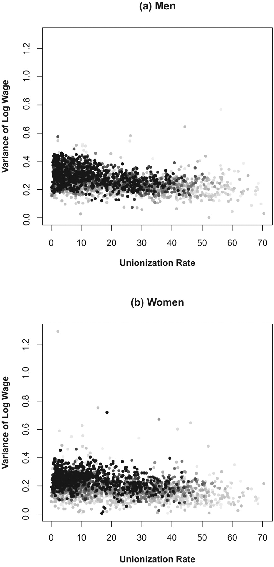August 30, 2011
Sociologists Bruce Western and Jake Rosenfeld have a great paper in the current issue of the American Sociological Review on the effect of unions on wage inequality in the United States.
Researchers including David Card (pdf), Richard Freeman, John DiNardo (pdf) and others long ago established that unions reduce wage inequality, primarily by compressing wage differences within unionized firms. Western and Rosenfeld’s paper extends this research by demonstrating that unions also reduce inequality through a second channel: by lowering wage inequality among non-union workers that work in more heavily unionized industries and areas.
The specifics are somewhat technical, but the graphs below illustrate the main findings. The two researchers divided the economy into a large number of industry-and-region groups and then measured the unionization rate and the wage inequality (the variance of the log of wages) in each group in each year from 1973 to 2007. Overall, and especially for men, the higher the unionization rate in the industry-and-region group, the lower the overall level of wage inequality. Statistical techniques allowed Western and Rosenfeld to separate the part of the lower inequality that was due to lower inequality within the unionized workforce and the part that was related to lower inequality among non-unionized workers in each industry-region grouping.

Unionization Rates and the Variance of Log Hourly Wages for Full-Time, Private Sector, Male and Female Nonunion Workers, by 72 Industry-Regions, 1973 to 2007 Note: Points go from light gray to black, from 1973 to 2007. Source: Western and Rosenfeld.
How is it that unions affect the wages of non-union workers? One way is through what economists call a “threat effect.” In industries and regions where unionization is more likely, non-union employers may offer better wages, benefits, and working conditions in order to pre-empt union organizing. But, Western and Rosenfeld emphasize another possibility. They believe that higher rates of unionization may “contribute to a moral economy that institutionalizes norms for fair pay, even for nonunion workers.”
Taking the effect on both union and non-union workers into account, Western and Rosenfeld conclude that the steep decline in unionization in the United States since the early 1980s “explains a fifth to a third of the growth in inequality.”
This post originally appeared on John Schmitt’s blog, No Apparent Motive.






